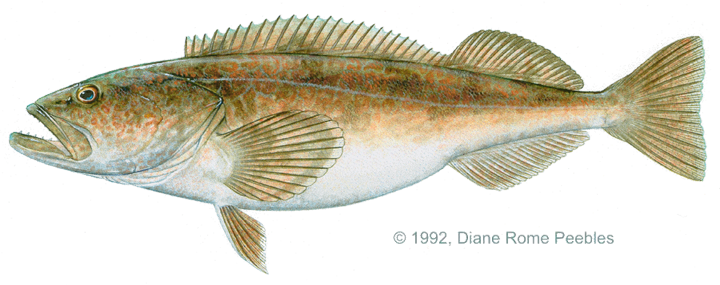Game Fish Identification Reference Guides
Lingcod
(Ophiodon elongatus)
(Ophiodon elongatus)

Girard, 1854; HEXAGRAMMIDAE FAMILY; also called ling, cultus cod, green cod, buffalo cod
Endemic to the eastern Pacific Ocean from Point San Carlos, Baja California, Mexico, north to Kodiak Island, Alaska. Juveniles may be caught near kelp beds and rocky areas. Adults tend to remain in deeper water, and have been taken as deep as 1,381 ft (421 m), although they are most common at depths less than 350 ft (106 m).
It is recognized by a combination of characteristics. The mouth is large and slightly upward directed with a projecting lower jaw; the maxillae (upper jawbones) extend back beyond the posterior margin of the eyes. The large canine teeth are responsible for the genus name Ophiodon, derived from the Greek words “ophis” (snake) and “odons” (tooth). There is a single, continuous dorsal fin with a dip between the spiny anterior portions and soft rayed posterior part. The pectoral fins are large and fan like. The head and body are covered with small, smooth, cycloid scales, giving the fish a smooth look. Color is highly variable with habitat and may be almost any shade of brown, black, gray, blue or green with darker mottling.
They are voracious feeders that readily devour flounders, hake, herring, rockfish, cod, and even their own species, as well as crustacean and octopus. They are most commonly taken on heavy jigs fished in 30 700 ft (9 213 m) of water. They have been known to chase down and inhale hooked salmon and other fish being played by anglers, often refusing to let go until lifted out of the water. Lingcod are highly regarded sport fish and food fis
Endemic to the eastern Pacific Ocean from Point San Carlos, Baja California, Mexico, north to Kodiak Island, Alaska. Juveniles may be caught near kelp beds and rocky areas. Adults tend to remain in deeper water, and have been taken as deep as 1,381 ft (421 m), although they are most common at depths less than 350 ft (106 m).
It is recognized by a combination of characteristics. The mouth is large and slightly upward directed with a projecting lower jaw; the maxillae (upper jawbones) extend back beyond the posterior margin of the eyes. The large canine teeth are responsible for the genus name Ophiodon, derived from the Greek words “ophis” (snake) and “odons” (tooth). There is a single, continuous dorsal fin with a dip between the spiny anterior portions and soft rayed posterior part. The pectoral fins are large and fan like. The head and body are covered with small, smooth, cycloid scales, giving the fish a smooth look. Color is highly variable with habitat and may be almost any shade of brown, black, gray, blue or green with darker mottling.
They are voracious feeders that readily devour flounders, hake, herring, rockfish, cod, and even their own species, as well as crustacean and octopus. They are most commonly taken on heavy jigs fished in 30 700 ft (9 213 m) of water. They have been known to chase down and inhale hooked salmon and other fish being played by anglers, often refusing to let go until lifted out of the water. Lingcod are highly regarded sport fish and food fis












